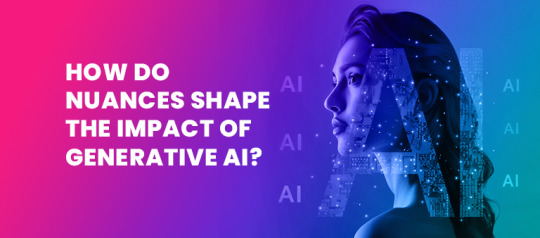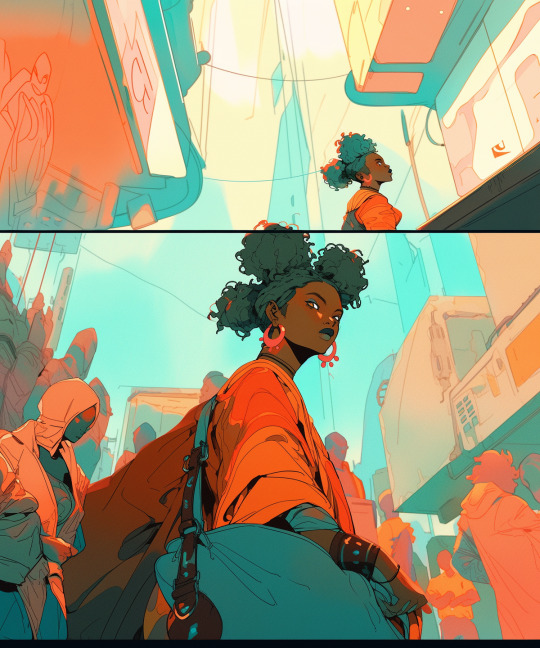#Future Of Generative AI
Explore tagged Tumblr posts
Text
See how the nuances of generative AI drive breakthroughs and challenges in industries, shaping its overall impact.
#AI Boosting Productivity#Benefits Of Generative AI#Future Of Generative AI#Generative AI#Generative AI Applications#Generative AI Capabilities#Limitations Of Generative AI#Role Of Generative AI
0 notes
Text
How Do Nuances Shape the Impact of Generative AI?
See how the nuances of generative AI drive breakthroughs and challenges in industries, shaping its overall impact. Generative AI is revolutionizing industries through increased creativity, new productivity, and innovation. However, the contextual details that are inherent in this technology make a significant difference between its efficiency, trustworthiness, and repercussions in society. In…
#AI Boosting Productivity#Benefits Of Generative AI#Future Of Generative AI#Generative AI#Generative AI Applications#Generative AI Capabilities#Limitations Of Generative AI#Role Of Generative AI
0 notes
Text
How Do Nuances Shape the Impact of Generative AI?
Learn how small nuances in data and algorithms significantly alter the outcomes and influence of generative AI technology.

Generative AI is revolutionizing industries through increased creativity, new productivity, and innovation. However, the contextual details that are inherent in this technology make a significant difference between its efficiency, trustworthiness, and repercussions in society. In this article, they have discussed certain critical aspects of Generative AI, including their significance, the consequences of these nuances and their role in the evolution of Generative AI.
Understanding the Nuances of Generative AI Technology
Generative AI is an advanced form of artificial intelligence which uses machine learning techniques, specifically the deep learning, to produce new content. Such content may be textual, graphical, musical, or even complex data mappings. The components are well established, and the control of the process relies on small parameters, or factors that are easily overlooked but can greatly affect the final result.
Part of the subtleties of Generative AI is the data used to train these models. The kind, variety and volume of the training data can greatly affect the generated output. The model trained from a small dataset may generate some bias and non-diverse content that may lead to production of wrong results. Further, there is the choice of algorithms and fine-tuning process, which add some fine details that determine how well an AI will generalize to new data or different contexts.
It is necessary to consider all these factors in dealing with Generative AI systems in order to achieve the best results possible. No matter whether it is about creating the application for content generation, design, or scientific research, a deeper understanding of the nuances of that technology can enhance the results and make the user be more aware of the technology’s strengths and weaknesses.
The Importance of Nuance in Generative AI Applications
Special considerations are critical in defining the performance of generative AI applications in various industries and geographical areas. For instance, in marketing, an advert created by an AI has to fit the cultural and social requirement of the intended information recipients for its effectiveness. Absence of subtlety is very dangerous as a communication can turn out to be either unimpressive or even provocative.
Think of automated content generation solutions only for product descriptions or customer outreach. These tools need to know not only concrete semantics of the words but also their nuances, which can be quite different when translated into different languages or used in different cultures. A generative AI system trained mostly on data from one region may not be as efficient in another as a result of these cultural disparities.
In addition, the use of nuance plays a significant role in how the AI handles the user’s interface. Here we have seen that in customer service, generative AI chatbots have to query and answer with sensitivity and understanding that cannot simply be achieved using the literal meaning of the words used. This includes understanding the emotional content and context of a conversation—features closely associated with variation in language.
Given that generative AI is becoming a part of day to day processes within organizations, there is a need to ensure that AI systems deployed are culturally and contextually competent. This has become quite important more so for companies that are in the global market since applying a singular strategy in various markets can cause misunderstanding.
Nuances in Language and Cultural Differences
Language is complex and holds several nuances that generative AI needs to understand in order to function optimally. Such details may range from colloquialisms specific to a region to idioms that cannot be literally translated from one language into another. For instance the English equivalent of “break a leg” used when wishing a person luck in his or her performance may have a negative impact on the person if interpreted literally.
Cultural factors add to these dynamics in even more ways including; The same thing that would be considered funny in one culture may be considered as a taboo in the other. Generative AI should capture these differences to ensure that it produces relevant and impactful content in all the cultures. This is particularly difficult because culture is not a fixed environment; it changes, and so should the AI that is interacting with it.
The generative AI issues that exist in this field are therefore complex. AI can not only identify these cultural and linguistic variations but also adjust the outputs based on them. This implies that there is need for development of complex algorithms that can easily identify difference in the usage of language and cultural differences and learn on this in real-time.
However, in the context of international business AI’s capability to manage such subtleties is a benefit. Some of the successful factors which portray Companies that employ AI system that has ability to recognize cultural sensitivity are favourable in International markets. This is the reason why while developing the AI technologies it is not enough to make them simply smart but also respecting the linguistic and cultural differences.
How Nuances Affect the Capabilities and Limitations of Generative AI
Content Quality:
Nuances directly impact the quality of AI-generated content. Decoding of top level contextual cues like the cultural or generational references enables the generation of a more fitting content by the AI. Without this, the output may have all the technical input, a human touch, which makes content engaging is missing.
User Interaction:
Nuances in language and tone significantly affect how users perceive and interact with AI. An AI system that does not recognize these nuances may create an awkward image of being cold and inattentive to the customer’s feelings and that would not go well with the user.
Ethical Considerations:
Nuances also play a crucial role in the ethical deployment of AI. For example, AI has to be very cautious when concerning such issues as it has to grasp the consequences of its outputs in certain cultures. Screw ups on this can cost you ethical violations and a tarnished reputation.
Adaptability:
Therefore, depending on the amount of nuance in new situations or data, this can or cannot manifest as an issue in the performance of generative AI. These systems are more adaptable and reliable for a wider range of uses because they have adapted to receiving new and varying inputs like multicultural or multilingual inputs.
AI Boosting Productivity:
Nuanced understanding enables AI to enhance productivity by generating content that is not only correct but also contextually appropriate and effective. This capability is important in industries as marketing, customer service and content creating businesses where communication matters most.
Navigating the Nuances to Maximize the Benefits of Generative AI
Training with Diverse Data:
Yet to address the nuances, generative AI systems should be trained on a diverse set of data that contains cultural, linguistic and contextual information. This means that the AI will be able to understand the nuanced differences between areas and sectors within the world.
Continuous Learning:
AI systems needs to be made capable of learning as new data appears in the environment and particularly cultural norms as language evolves. The existence of feedback loops that permit modification of AI results depending on the users’ responses can greatly improve its performance.
Ethical Frameworks:
Ethical frameworks are hence key since they will help AI to avoid socially sensitive matters, as well as accommodate for cultural differences. These frameworks should be embedded into the AI’s decision-making algorithms so that the outputs are not only correct but also culturally sensitive.
Customizable Outputs:
Enabling users to customize AI-generated content eliminates the problem created by nuances as users can customize them. This way the AI system allows users to have more control over the tone, style and the cultural context of the output which makes the result to be more suitable to the identified needs.
Collaboration with Human Experts:
Combining AI’s computational power with human expertise can help navigate nuances more effectively. This human intervention also enshrines appropriateness and ethical considerations of the AI-produced information especially in critical environments.
Conclusion: Embracing the Nuances of Generative AI for Positive Impact
As the generative AI progresses, its potential will also depend on how well the AI systems will understand language, culture, and context. This understanding is now vital for businesses and developers to achieve all the benefits that AI has to offer. However, it becomes possible to accept those issues and consider enhancing strategies to follow them, as it opens doors to develop new potential of AI, improve interpersonal communication, and advance innovation in various fields.
Overall, the future of generative AI is promising, but it will be important to grasp and orient the highly contextual and flexible ways in which it relates to reality. By adhering to the best practices mentioned above regarding generative AI including, data quality, continual learning and incorporating ethical principles, the role of generative AI can be leveraged to its full potential in a way that benefits society and improves the nature and efficacy of every application.
Original source: https://bit.ly/3MrYDIf
#AI Boosting Productivity#Benefits Of Generative AI#Future Of Generative AI#Generative AI#Generative AI Applications#Generative AI Capabilities#Limitations Of Generative AI#Role Of Generative AI
0 notes
Text


#digital art#illustration#cybercore#octane#octanerender#3d art#artwork#artists on tumblr#ai artwork#cyberpunk aesthetic#ai art#cyberpunk 2077#ai generated#3d blog#art#blender#cyber girl#cybersecurity#cyberpunk photomode#futuristic#future#techcore#scifiart#ai girl#ai#artificial intelligence#ai sexy#ai woman#bath#swim
123 notes
·
View notes
Text
Attention Artists!
We've reached the point when you can have AI generated "speedpaints".
The way they work is by giving the engine an image to make a "speedpain" video from. Please don't be fooled! Althought the AI is quite good at showing you different stages of the drawing process (sketch, clean up, colors, final render) there's still a few things to keep in mind to recognize these AI generated videos.
These videos are basically just a collection of images, they do not show each stroke of the pen. This is not a perfect tell because actual drawing apps, like Procreate, Ibis Paint X, and other programs with built in timelapses work similarly. These programs do not screen record, rather record each time you put the pen down and lift it up, so a long line won't show up progresively, it will just suddenly appear on screen. That said, it is a good thing to keep in mind when trying to recognize AI generated "speedpaints".
Some of the tells I recognize are:
Related to my point above, the AI generated "speedpaints" tend to make big changes that just show up. It's not like that straight line just appeared on screen because the artist did it in one stroke, it's more like that whole entire head just appeared. No artist can draw lots and lots of separated details in just one stroke.
The AI has significantly more trouble with backgrounds. It will just fully render a bunch of backgrounds until it lands on the correct one. No sketch, no flat colors, nothing.
The problem with a style consistency is still present, and it is more noticable when it's on a video. There will be multiple sketches of the same character in widely different styles until it lands on the one from the prompt picture.
This also happens with reder styles. You will see a picture go from a watercolor render to a painterly one to flat colors and the changes happen quite fast.
It will move from sketch to color back to sketch a lot. Sometimes a part of the "art" will be fully rendered and then suddenly change shape to be what's esentially a different sketch, but still be fully rendered without showing the full process.
When something on the sketch is wrong, instead of fixing just that detail, the AI tends to just fully "sketch" everything again
There is A LOT of color correction before the "drawing" is finished. Although artist do color correct in order to get to a palette they like, it usually isn't done throughout the entire drawing process.
The image will go from being very sharp with thin lines to very blurry with the characteristic melty look of AI generated "art". The color of the lines and background will also change a little. This is mostly visible during the sketch stage.
These are just some of the tings that stand out to me, Please check out this video by actual artist Lola Holliday about it. You cans ee some examples of these AI generated "speedpaints". And you can compare it with real speedpaints as well.
youtube
Please be careful and don't get scammed by these idiots. And also, support real artists please.
#ok that was a long post sorry#i just fucking hate ai generated crap#and i'm scared for my future as an illustrator#also be careful when posting speedpaints cause i guess they're training this with youtube and tiktok? who knows#angel talks#art#anti ai#fuck ai#ai bullshit#long post#Youtube
129 notes
·
View notes
Text

Goddess rising
#art#fantasyart#picsart#ai art#ai generated#ai girl#ai artwork#black girl magic#afrikan beauty#africanart#black beauty#goddess#black woman beauty#urban art#afrofusion#afrofuturism#afrocentric#africa#black goddess#grand rising#ascension#surrealism#futurism#lexicaaiart#Adobe ai#digital art#digital illustration#aiartcommunity#aiartcreator#ai artist
231 notes
·
View notes
Text

"Mlinzi wa Taifa" (0001)
(The Protector of the Nation Series)
#ai man#shaman#protector#long haired man#muscular#cybernetic#bionic#transhuman#bearded man#male form#male physique#male figure#black male body#black male beauty#ai generated#ai artwork#gay ai art#gay sci fi#gay sci fi art#gay fantasy art#futuristic#art direction#fashion illustration#ai gay#ai fashion#abdominals#scifi#futurism#hero
63 notes
·
View notes
Text
Even More Spaceships









#spaceships#spaceship#derelict#scifiart#sci fi art#spaceart#midjourney#ai artwork#space art#generative art#futurism#YAN61#yan61#image prompt#futuristic#midjourney v6#oc image prompt#long post
232 notes
·
View notes
Text
Learn how small nuances in data and algorithms significantly alter the outcomes and influence of generative AI technology.
#AI Boosting Productivity#Benefits Of Generative AI#Future Of Generative AI#Generative AI#Generative AI Applications#Generative AI Capabilities#Limitations Of Generative AI#Role Of Generative AI
0 notes
Text

Traveler
#art#afrofuturism#cyber punk#cyberpunk#fashion#black women are beautiful#street art#street wear#afro futurism#anime#ai#travel#anime and manga#retro anime#visual archive#afro futuristic#ai generated
457 notes
·
View notes
Text

Artwork from the "Futuristic Woman" collection.
#ai cutie#ai work#ai babe#ai girl#ai artwork#ai image#ai#ai generated#ai art#artificial intelligence#ai women#ai woman#ai world#ai community#aiartcommunity#ai artist#ai future#ai sci fi#ai sexy#black beauty#afrikan beauty#nft#nftart#nftcollection#nftcommunity#nftcollector#afrofuturism#afrocentric#afrofuturistic#afro
27 notes
·
View notes